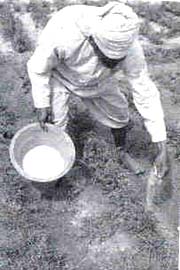Split profits
 WHEN applying fertilisers to crops, it is not so much the quantity as the timing that decides how good the yield will be, concludes a team of biochemists at the nuclear research laboratory of the Delhi-based Indian Agricultural Research Institute (IARI).
WHEN applying fertilisers to crops, it is not so much the quantity as the timing that decides how good the yield will be, concludes a team of biochemists at the nuclear research laboratory of the Delhi-based Indian Agricultural Research Institute (IARI).
Led by Sukumar R Chatterjee, the team traced the uptake of nitrogen fertilisers by plants, using fertilisers labeled with radioactive nitrogen. They found that plants rarely consume more than 45 per cent of the 120 kg of nitrogen fertilisers normally applied as a basal dose for cereal crops when the field is prepared for sowing. The rest goes waste and could pollute groundwater.
Chatterjee and his team have spent the past 8 years trying to determine the appropriate dosage and timing for applying fertilisers to cereal crops cultivated under Indian conditions. The scientists exposed plant leaves that were plucked at various stages of the plant's life-cycle to nitrate solutions. They measured the activity of nitrate reductase -- a plant enzyme that converts complex nitrates into simpler forms that the plant can use. They found that this enzyme was active at distinct periods in the plant's life, when growth was maximum. Nitrogen was necessary when seeds germinated, when new shoots appeared (tillering) and when the grain was being developed.
The scientists say that if nitrogen is made available to the plants at these 3 stages, or in "splits" rather than in a larger basal dose, it would be more efficiently used by the plants.
To test their hypothesis, they ran experiments with 5 different barley varieties. Nitrogenous fertiliser was provided to one set of barley plants at 3 stages -- at the time of sowing, when new shoots began to emerge, and when new seed began to set. Another batch was provided nitrogen only at sowing and tillering, and the third batch only received a basal dose.
Their results reveal that yields were the highest when 20 kilograms of nitrogen were applied in 3 splits. There was no significant increase in yields when 30 kg of fertiliser was applied in 3 splits. In several barley varieties, yields increased between 7 to 25 per cent in the former case.
